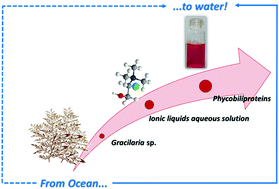Recovery of phycobiliproteins from the red macroalga Gracilaria sp. using ionic liquid aqueous solutions†
Abstract
Bioactive compounds extracted from natural renewable sources have attracted increased interest from both industry and academia. Several biocompounds are present in red macroalgae, among which R-phycoerythrin (R-PE), which is a phycobiliprotein with a wide range of applications. The major drawback associated with it is the absence of an efficient, low cost and green extraction and purification methodology capable of recovering phycobiliproteins (and, in particular, R-phycoerythrin) from the biomass, while maintaining their structure and activity. The search for novel and higher performance extraction processes is thus of extreme relevance. In this work, aqueous solutions of ionic liquids were screened for the extraction of phycobiliproteins from Gracilaria sp. The most promising solvents were identified and operational conditions such as extraction time, solid–liquid ratio, solvent concentration and pH were optimized aiming to develop a new and more efficient approach to extract phycobiliproteins. The efficiency of the proposed process is demonstrated with aqueous solutions of cholinium chloride, since the extraction of phycobiliproteins was increased to 46.5% when compared with the conventional methodology, while the protein secondary structure and the chromophore conformation integrity are maintained.



 Please wait while we load your content...
Please wait while we load your content...